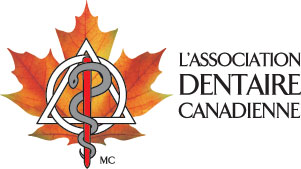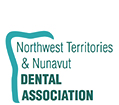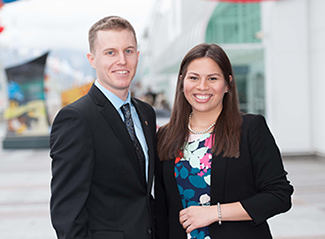 Les gagnants du Programme de recherche des cliniciens étudiants ADC/DENTSPLY de 2014 : Tobias Meiszinger, Université McGill (2e place); Kellyana Quattrini, Université de la Saskatchewan (1ère place).
Les gagnants du Programme de recherche des cliniciens étudiants ADC/DENTSPLY de 2014 : Tobias Meiszinger, Université McGill (2e place); Kellyana Quattrini, Université de la Saskatchewan (1ère place).
Le Programme de recherche des cliniciens étudiants ADC/DENTSPLY de 2014 s’est tenu à Vancouver en mars dernier lors du congrès dentaire du Pacifique. Ce concours national de recherche clinique invite des étudiants des 10 facultés de médecine dentaire agréées du Canada à présenter devant des juges des démonstrations cliniques de leur travail de recherche.
Kellyana Quattrini, de l’Université de la Saskatchewan, a été la grande gagnante cette année. Par le biais de son étude – menée en concert avec deux collaboratrices, Anapuala Campos et Jenna Schmitt –, cette dernière a développé et testé un nouveau matériau de restauration sans mercure. Son premier prix lui donne droit à un voyage tous frais compris au congrès annuel de l’Association dentaire américaine (ADA), où elle présentera sa recherche dans le cadre du programme scientifique de l’ADA.
« L’engagement à l’égard de la recherche manifesté par l’ADC et DENTSPLY est franchement fantastique et névralgique pour l’avenir de notre profession », souligne Mme Quattrini. Au nom des collaboratrices de son étude, elle ajoute : « Nous sommes très heureuses de représenter notre université et d’avoir l’occasion unique d’apprendre d’autres étudiants cliniciens et de maîtres du secteur.»
M. Tobias Meiszinger, de l’Université McGill, s’est quant à lui classé deuxième et a reçu comme prix une somme de 1000 $. Les travaux de M. Meiszinger et de sa collègue Gabrielle Lemay ont porté sur la formation en soins spéciaux en dentisterie dispensée par les universités canadiennes. « Ce que j’ai le plus aimé, c’est la possibilité de me servir de mes résultats de recherche comme levier pour défendre les personnes ayant des besoins particuliers. C’est une grande leçon d’humilité de rencontrer des professionnels de la médecine dentaire qui sont des défenseurs de longue date de ces personnes et qui reconnaissent l’importance offrir aux étudiants en médecine dentaire une expérience didactique et clinique auprès de ces patients », explique M. Meiszigner.
DENTSPLY commandite la Programme de recherche des cliniciens étudiants depuis 1971. Le programme vise à « susciter des idées, d’améliorer les communications et, par-dessous tout, d’accroître la participation des étudiants au progrès de la profession dentaire ».
La division canadienne de l’Académie Pierre Fauchard rend également hommage aux cliniciens étudiants qui participent au concours en leur présentant une bourse en reconnaissance des efforts déployés pour la promotion de l’éducation dentaire, indépendamment de leur carrière universitaire.
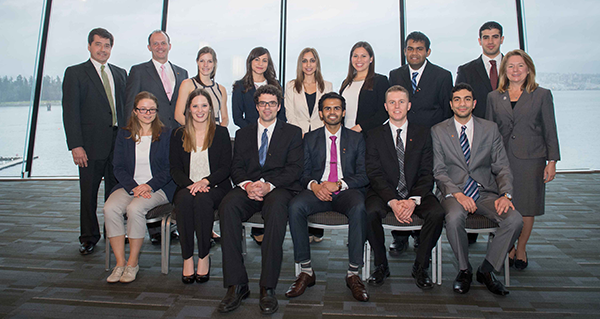
Devant (g. à d.) : Sofia Kholmogorova, Université de Montréal; Jenna Schmitt, Université de la Saskatchewan; Richard Miron, Université Laval; Gurinder Boparai, Université du Manitoba; Tobias Meiszinger, Université McGill; Muhammed Al-Nuaimi, Université de l’Alberta.
Derrière (g. à d.) : David Hancin, vice-président et directeur général, DENTSPLY Canada; Dr Peter Doig, président de l’ADC; Allie Anderson, Université Dalhousie; Anapaula Campos, Université de la Saskatchewan; Natasha, Université de Toronto; Kellyanna Quattrini, Université de la Saskatchewan; Joel Keshwah, école de médecine et de médecine dentaire Schulich; Kambiz Vatandoost, Université de la Colombie-Brittanique; Dre Teresa A. Dolan, vice-présidente et chef des services cliniques, DENTSPLY International.
L’ADC a le plaisir de publier les sommaires qui ont été présentés dans le cadre du Programme de recherche des cliniciens étudiants ADC/DENTSPLY 2014. Pour être admissible, le projet de recherche doit s’inscrire dans l’une des deux catégories suivantes : « applications et techniques cliniques » ou « science et recherche fondamentales ». Les étudiants doivent indiquer le but de leur étude, fournir des renseignements généraux, décrire brièvement la façon dont l’étude a été menée et présenter les résultats de l’étude et leur signification possible. Les candidats retenus sont choisis par leur faculté respective; ces candidats doivent poursuivre des études de premier cycle au moment de la présentation de leur projet et ils doivent être membres de l’ADC.Les 10 facultés de médecine dentaire ont participé au programme cette année.
Bien que certains cliniciens étudiants aient collaboré avec d’autres étudiants ou membres de leur faculté dans le cadre de leur projet de recherche, seuls les noms des présentateurs officiels apparaissent avec les sommaires. Les sommaires sont publiés dans la langue de soumission.
1ère place : A Novel Mercury-Free Restorative Material
Par : Anapaula Campos, Kellyana Quattrini et Jenna Schmitt – Université de la Saskatchewan
Conseillers : Dre Azita Zerehgar et Dr Assem Hedayat
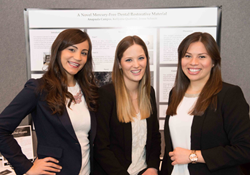
Problem: This research aimed to develop and subsequently test a novel restorative material created through compositional modifications of conventional amalgam. Although dental amalgam is commonly used in restorative dentistry, its mercury component is associated with perceived health hazards. Modifications were made to Permite amalgam to eliminate the presumed adverse effects of mercury, impart antimicrobial properties, and reduce the pressure needed to properly condense conventional dental amalgam.
Methods: Conventional regular-set Permite alloy, vinyltriethoxysilane-sialinized titanium dioxide ceramic (VSTDC) nanoparticles (60nm), and a proprietary silver solution were used to create the novel restorative material. Experimentation consisted of completely eliminating the mercury content in Permite amalgam and replacing it with the silver solution and VSTDC nanoparticles. The silver solution and VSTDC nanoparticles were triturated with the Permite alloy.
All components of the mixture were tested in variable amounts until an optimal consistency of the experimental restorative material was obtained. Prepared maxillary premolars were divided into a control group filled with Permite amalgam, and an experimental group filled with the novel material. Both groups were thermocycled, cross-sectioned, and studied through scanning electron microscopy (SEM).
Results: Triturating 600mg Permite alloy, 600mg VSTDC nanoparticles and 3.0ml of silver for 20 seconds yielded the most optimal consistency. SEM images obtained from the control and experimental groups of cross-sectioned teeth revealed superior marginal adaptation of the novel material compared to Permite amalgam; this was achieved by applying reduced condensation pressure in comparison to Permite amalgam.
2e place: The Place of Special Care Dentistry Training in Undergraduate Dental Studies
Par : Tobias Meiszinger, Université McGill
Conseillère : Dre Zovinar der Khatchadourian
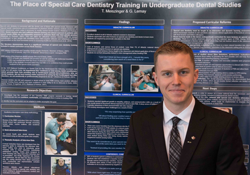
Problem: Prior research suggests that North American dental students lack sufficient didactic training about and clinical exposure to patients with special needs (PSN). As a result, graduating students are not adequately prepared to welcome PSN into their private practice.
Methods: A qualitative descriptive case study methodology was used. Data collection included: 1) review of the DMD curriculum from one Canadian dental school; 2) semi-structured interviews of fourth year dental students (n=10) recorded and analysed for themes regarding didactic and clinical educational experiences related to PSN and issues relating to confidence, comfort, and motivation to treat PSN.
Results: Student recall of didactic material was excellent demonstrating great interest in special care dentistry; however, less than 1% of didactic curriculum focuses on PSN.
Supervised clinical exposure (SCE) to PSN helped students challenge pre-existing stereotypes and develop empathy, patience, and communication skills. Learning was compromised due to a lack of previous student exposure to PSN, poor clinical training prior to SCE, and the stressful environment of SCE.
90% of students reported confidence and comfort with communicating with PSN; however, students lacked clinical confidence. Students were aware of their social responsibility to treat PSN yet motivation was hindered for 20% because of stressful SCE experiences.
Didactic material presented in an interactive environment, covering clinical strategies for a wide range of PSN, and strategically scheduled would benefit student learning and ease transition into SCE. Feasible solutions exist to increase student exposure to PSN prior to SCE. Structured student reflection may also consolidate clinical learning experiences.
Predictors of Success for the Immediate Loading of Implant Restorations
Par : Allie Anderson, Université Dalhousie
Conseiller : Dr M. Gorman Doyle
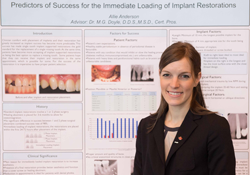
Problem: Implant restorations are becoming increasingly more popular amongst the general public for the replacement of a single missing tooth. Many patients believe that an implant and the restoration can be placed in just one appointment. However, specific criteria need to be satisfied for successful immediate implant restorations.
Methods: A literature review was conducted using PubMed. Various combinations of the following search terms were used: “immediate loading”, “dental implant”, “primary stability”, “implant length”, “loading failure”, “maxillary and mandibular position”, and “insertion torque”. Searches were limited to clinical trials, randomized controlled trials, and systematic reviews written in English.
Results: A comprehensive list of the factors involved in the success of immediate loading of implant restorations was compiled. The factors can be broken down into four main categories: 1) patient, 2) implant, 3) surgical and 4) post-surgical. Each category has several criteria that must be met to ensure long-term success of the implant. Diagnosis using these factors will help clinicians decide if a patient is suitable for immediate loading of an implant restoration.
In conclusion, there are situations where immediate loading of implant restorations is a viable treatment option. The risks and benefits of both immediate loading and conventional delayed loading implant restorations must be discussed with the patient. If the patient has the favorable characteristics, immediate loading of the implant should be considered as a treatment option.
Effectiveness of an Oral Health Education Workshop for African Immigrant Parents.
Par : Muhammed Al-Nuaimi, Université de l’Alberta
Conseillère : Dre Maryam Amin
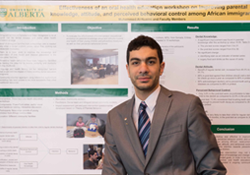
Objectives: To evaluate the effectiveness of a one-session educational workshop on parental knowledge about and attitudes toward oral health of their young children and preventive measures as well as their perceived behavioral control.
Methods: A three-hour oral health education workshop including audio/visual and hands-on components was developed. Participants were parents of young children who had lived in Canada for less than ten years. The workshops were conducted in different community locations by a trained dentist and bilingual community workers who also helped with recruitment, interpretation, and administration of the questionnaires. The impact of the workshop was evaluated using a pre- and a post-intervention questionnaire developed based on theory of planned behavior.
Results: A total of 105 African parents participated in 10 workshops. They were mainly mothers (86.1%) with mean age of 35.03 + 5.4 years who came to Canada as a refugee (77.1 %) and had three or more children (49.5%). About 70% of the participants had below high school education,
39% were single parent, and 39% had monthly income below $2000. A statistically significant improvement was found in participants’ knowledge about caries and preventive measures, attitudes towards preventive measures, and their perceived behavioural control. Parents’ intention to take their child to a dentist within the next six months also significantly altered after the workshop (p value <0.05).
Conclusions: A hands-on training of newcomer parents in respect to children’s oral health was effective in changing their knowledge, attitudes, and intention to take action in a foreseeable future.
Tracking Early Visits to the Dentist: A Look at the First 3 Years of the Free First Visit Program
Par : Gurinder Boparai, Université du Manitoba
Conseiller : Dr Robert Schroth
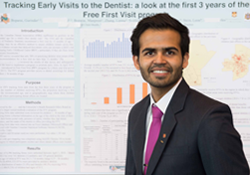
Problem: Early visits to the dentist are important to ensure children have good oral health. The
Free First Visit (FFV) program was launched to provide access to dental screenings for children ≤ 36 months of age. The purpose was to review FFV tracking forms submitted by participating dentists.
Methods: Submitted tracking form data from participating dental offices were reviewed for children ≤36 months of age. These forms collected information on the age of the child at the time of their FFV, their home postal code, if they had any caries, the dentist’s name, and whether they had dental insurance benefits. Descriptive and bivariate analyses were performed. Geo-mapping was completed using ArcGIS.
Results: 8,396 tracking forms were submitted. The mean age at first visit was 24.2 ± 7.8 months. While only 8.5% had a FFV by 12 months of age, 26.7% had a FFV by 18 months of age. Postal code mapping revealed that participation was highest among children in the southern region of the province, including high-needs neighbourhoods within the capital city. Pediatric dentists provided the majority of the FFVs and saw significantly younger children compared to general dentists (23.8 ± 7.8 months vs. 25.2 ± 7.7, p <.001). Results suggest many children participated and received a FFV. However, only a small percentage received visits by 12 months of age.
There is a need to improve the proportion of children receiving first visits by the recommended age and general dentists need to assume a greater role in providing this service.
Effects of Nanotopographies on Osteoblast Adhesion, Migration and Fibronectin Fibrillogenesis
Par : Joel Keshwah, École de médecine et de médecine dentaire Schulich
Conseiller : Dr Douglas Hamilton
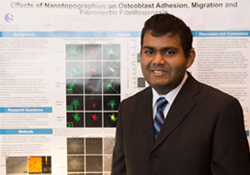
Problem: The success of dental implants depends on proper balance of bone formation and resorption. Osteoblasts, which form bone, adhere and sense their environment via focal adhesions. Changes to the substratum topography of implants, is a desirable way to influence osteoblasts, since it persists for the lifespan of the implant. Our study assessed the influence of nanotopographies on osteoblast adhesion, migration and fibrillogenesis.
Methods: Rat calvarial osteoblasts were seated on glass slides, with nanotopographies etched into the surface (lines, dots). Immunocytochemistry was used to assess adhesion site anchoring proteins vinculin, tensin and extracellular matrix (ECM) molecule fibronectin. Cell migration was analyzed using time-lapse video (TLV).
Results: Focal contacts formed at the peaks of topographies in cells on dot surfaces, while focal contacts formed parallel to the long axis of the topography on grooved surfaces. Cells on smooth surfaces formed large adhesion plaques with random orientation. Fibrillar adhesions showed similar, but less pronounced patterning as focal contacts. TLV showed cells on line surfaces migrated in the direction of the topography while cells on other surfaces migrated randomly. No significant difference was seen in migration velocity or distance travelled, but cells on lines and dots tend to travel faster and farther. After 72 hours, cells on grooved surfaces developed fibronectin fibrils parallel with the topography, while fibronectin on dot and smooth surfaces had a random orientation. In conclusion, substratum nanotopographies can manipulate osteoblast physiology and by understanding its impact, novel implants that facilitate osseointegration through effects on bone remodeling can be designed.
Integrity of the Junctional Epithelium: Structural and Functional Studies of Novel Inner Basement Membrane Components
Par : Sofia Kholmogorova, Université de Montréal
Conseillère : Dre Annie St-Georges
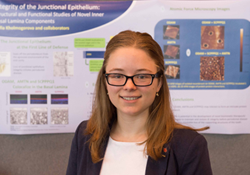
Functional genomic screening of the rat enamel organ has led to the identification of Amelotin (AMTN), Odontogenic ameloblast-associated (ODAM) and SCPP-Proline- Glutamine-rich 1 (SCPPPQ1) as novel secretory products of maturation stage ameloblasts. These proteins are also produced by the junctional epithelium (JE) and localize to the basal lamina of the epithelial attachment where they seal off the periodontium from the aggressive oral environment. Understanding how the JE binds to the tooth is therefore of high clinical relevance. We have exploited atomic force microscopy (AFM) to obtain structural information on recombinant rat ODAM, AMTN and SCPPPQ1, to visualize their potential interactions. Each protein resulted in a distinct pattern of distribution on an atomically neutral surface. When they were added sequentially to the substrate, change in the resulting pattern suggested protein interactions. Images of AMTN layered onto SCPPPQ1 revealed intriguing 100 nm pores in a homogenous background matrix. Interestingly, the addition of ODAM over the layered SCPPPQ1 and AMTN resulted in a reduction of the pore size. These data suggest that AMTN, ODAM and SCPPPQ1 are capable of self-assembly and that protein-protein interactions occur among them. These analyses represent a first step towards exploring the molecular arrangement and interactions of proteins in the JE basal lamina and how these result in a unique adhesive relationship with the tooth. The application of one or all of these proteins may potentially represent a novel biomimetic therapeutic strategy to maintain and restore JE integrity before periodontal disease causes the inevitable loss of the supporting structures of the tooth.
Osteoinductive Potential of Commonly Employed Bone Grafts – The Development of Vivoss
Par : Richard Miron, Université Laval
Conseillère : Dre Fatiha Chandad
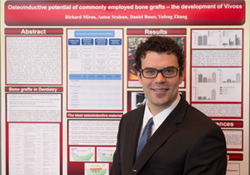
Since the original description of osteoinduction in the early 20th century, the development of innovative biomaterials with osteoinductive potential has emerged. Over the last 50 years however, our ability to accurately describe biological phenomenons has been drastically improved by advancements in cell and molecular biology. The aim of the present study was to compare the osteoinductive potential of bone grafts by comparing autogenous bone, demineralized freeze-dried bone allografts (DFDBA), a commonly utilised xenograft (BioOss) and a newly developed biphasic calcium phosphate. Grafts were compared in vitro for their ability to stimulate mesenchymal cell migration, proliferation and differentiation as assessed by alkaline phosphatise (ALP) activity and real-time PCR for bone-markers including Runx2, ALP, collagenI, and osteocalcin. Furthermore, bone grafts were implanted in the calf muscle of beagle dogs to determine their potential to form ectopic bone in vivo. The results from the present study demonstrate that while xenografts were not osteoinductive and autogenous bone grafts were resorbed quickly in vivo, major differences in the bone inducing capabilities between DFDBA and synthetic biphasic calcium phosphate alloplasts were observed. The modifications in nanotopography and chemical composition of the new biphasic calcium phosphate bone graft significantly improved osteoblast differentiation and promoted ectopic bone formation. Although the future field of osteoinductive biomaterials faces many challenges in order to meet the incoming demand for bone grafting procedures worldwide, the results from the present study provide evidence that modifications to synthetic bone grafts no longer only serve as a 3-dimensional scaffold but are also able to spontaneously induce bone formation.
Novel Minimally-Invasive Means to Survey Bacterial Biomarkers Under Chronic Periodontitis
Par : Natasha, Université de Toronto
Conseillère : Dre Dilani Senadheera
Problem: Periodontitis, a significant oral health burden, is a consequence of microbial dysbiosis that elicits an inflammatory response destroying tooth-supporting structures. Of several varieties, chronic periodontitis (CP) remains the leading cause of tooth exfoliation worldwide. Conventionally, treatment outcomes against periodontitis are monitored via culturing/immunostaining of odontopathogens in subgingival (SubG) plaque. Hypotheses: In lieu of SubG sampling, selected bacterial biomarkers associated with CP are quantifiable using supragingival (SupG) or tongue plaque by determining bacterial relative abundance (RA) with real-time PCR (RtPCR).
Methods: DNA was extracted from 72 plaque samples (SupG, SubG and tongue sites) from 11-healthy and 13-CP individuals. RtPCR was used to quantify bacterial load and RAs of Tannerella forsythia (Tf), Porphyromonas gingivalis (Pg), Rothia dentocariosa (Rd), Filifactor alocis (Fa) with 16S rRNA gene- specific primers. Statistical analysis: Two-way-ANOVA/ Tukey's post-hoc test.
Results: Bacterial load was unaffected by disease status. Pg and Tf represent the most abundant taxa under CP, with significantly increased Pg levels in all sampling sites. Rd numbers were increased under health. Tf and Fa levels were drastically elevated in SubG and SupG sites, although Fa increase was not statistically significant.
Conclusions: SupG and tongue sites harbor significantly altered levels of selected bacterial biomarkers depending on periodontal health that are quantifiable with RtPCR. Presently, we are examining RAs of >15 putative periodontal pathogens in different oral sites. Here, we report a novel and convenient method to sample and quantify CP-associated taxa that provides critical groundwork to develop a rapid and minimally-invasive strategy to monitor treatment modalities against CP.
Differential Regulation of Keratincyte Function by Skin and Gingival Fibroblasts
Par : Kambiz Vatandoost, Université de la Colombie-Britannique
Conseiller : Dr Ravindra M. Shah
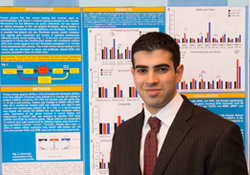
Objectives: Human gingiva has fast wound healing that involves rapid re-epithelialization and results to minimal scaring compared to skin wounds. Mechanisms for this difference are poorly understood but may depend on distinct phenotype of skin and gingival fibroblasts. Wound healing is regulated by cross-talk between epithelium and connective tissue cells. Therefore, we hypothesized that gingival and skin fibroblasts secrete soluble mediators that regulate gene expression and affect function of epithelial keratinocytes differently. To this end, we compared gene expression in human keratinocytes treated with conditioned medium (CM) from human gingival and skin fibroblasts propagated in in vivo-like three-dimensional (3D) cultures.
Methods: Fibroblasts from three parallel cell lines isolated from human skin (breast) and gingiva were cultured in an in vivo-like 3D culture, CM was collected and used to treat skin keratinocytes (HaCaT). Expression of key genes involved in wound healing and inflammation was analyzed by real-time RT-PCR.
Results: In general, CM from both gingival and skin fibroblasts regulated the expression of integrins, certain ECM proteins, cytokines, MMPs and cell proliferation, angiogenesis and cell communication-associated genes in keratinocytes. Expression of a set of genes involved in cell-ECM interactions, inflammation and angiogenesis were differently regulated by gingival and skin fibroblast CM in the keratinocytes.
Conclusions: Distinct composition of molecules secreted by skin and gingival fibroblasts regulate keratinocyte’s phenotype differently. This may contribute to the different wound-healing outcomes in skin and gingiva.
**
Photos : Teckles Photo Inc.
